Southern Africa Faces Severe Food Crisis Amid Historic Drought and Funding Shortfalls
The UN World Food Programme struggles to raise $400 million for drought relief in Southern Africa, securing only $80 million so far. The drought, caused by the El Niño phenomenon, has severely impacted harvests and increased food needs for seven countries. Urgent action is required to prevent worsening hunger.

The U.N. World Food Programme (WFP) is grappling with significant challenges in its efforts to raise $400 million for drought response in Southern Africa, having collected only a fifth of the required funds so far, according to spokesperson Thomson Phiri.
Phiri emphasized that the worsening funding environment has intensified the already critical food shortage in the region, which is enduring its worst drought in decades. The El Niño climate phenomenon has led to extreme seasonal temperatures and dry spells, devastating harvests and forcing Zambia, Malawi, and Zimbabwe to declare states of disaster.
Approximately 70% of the population in Southern Africa relying on rain-fed agriculture have seen their harvests devastated, Phiri reported. The WFP aims to support 27 million people until the next harvest in 2025, sourcing white grain from Tanzania, South Africa, and Latin America. Despite increased donor support, food needs remain exceptionally high, outpacing the available resources.
The UN's climate crisis coordinator for the El Niño response, Reena Ghelani, has called for immediate action, warning of prolonged dry spells and more frequent droughts due to climate change. The situation is dire, with a sharp rise in hunger across the region.
(With inputs from agencies.)










